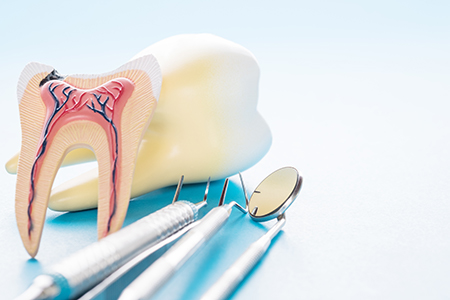
If a dentist tells you a tooth needs a root canal, don’t panic. Modern root canal therapy is a predictable, comfortable service that relieves deep tooth pain and preserves your natural tooth. In many cases it offers a better long-term outcome than removing the tooth, because keeping your own tooth helps maintain chewing function, jaw stability, and the appearance of your smile.
At the office of Fay Hu General Dentistry, we combine careful diagnosis with contemporary techniques to deliver precise, gentle care. Our team focuses on patient comfort throughout the process and takes time to explain each step so you feel informed and confident about treatment.
A root canal restores the inside of a tooth affected by injury, deep decay, or irreversible inflammation. When the tissues inside a tooth — the pulp — are compromised, leaving the problem untreated can cause persistent pain, infection, and damage to surrounding bone. Treating the root canal removes the source of trouble and allows the tooth to remain in place and function normally.
Opting for root canal therapy preserves your natural tooth structure and reduces the need for more extensive treatments later on. A restored natural tooth generally feels and performs more like a natural tooth than some replacement options, and it helps maintain the alignment of adjacent teeth.
Success with root canal therapy relies on accurate diagnosis, careful cleaning of the canal system, and an appropriate final restoration after treatment. With modern instruments and materials, most treated teeth can be expected to remain useful for many years when combined with good oral hygiene and routine dental care.

Teeth aren’t just hard surfaces; inside each one is a small chamber that contains nerves and blood vessels known as the dental pulp. The pulp helps a tooth develop and provides sensory feedback. When bacteria reach that chamber through deep decay, cracks, or traumatic injury, the pulp can become inflamed or die. That process often produces the symptoms patients notice.
Sensitivity to hot and cold, lingering pain after eating or drinking, pain with biting, or a tooth that darkens in color are signals that the pulp may be affected. Sometimes a tooth will show minimal symptoms yet reveal an infection on an X-ray — which is why routine dental exams and imaging remain important for catching problems early.
Left untreated, pulp infections can travel beyond the tooth to involve surrounding bone and soft tissues, producing swelling or drainage and sometimes making the tooth less stable. Timely evaluation and treatment help contain the problem and reduce the chance of more complex complications.
While not every toothache requires root canal therapy, the presence of persistent pain, clear radiographic changes around the root tip, or evident fracture or decay penetrating to the pulp are common reasons a clinician will recommend root canal treatment to save the tooth.
Pain that lingers or intensifies — especially pain that interrupts sleep or comes on without obvious cause — can indicate deep pulp involvement and usually merits prompt evaluation.
Extensive sensitivity to hot or cold that lasts after the stimulus is removed often reflects an inflamed or injured pulp.
A tooth that hurts under pressure can have internal damage or an infection that affects the supporting tissues.
Color changes may occur when internal tissues have been compromised; discoloration is a sign worth assessing.
Fractures can expose the inner tooth to bacteria and make the pulp vulnerable, often necessitating endodontic treatment to save the tooth.
Swelling of the gums or a persistent draining lesion are indications that infection has extended beyond the tooth and needs professional care.
Infection around the root can erode supporting bone and cause mobility; treating the root often allows healing and stabilization.

Zoning in early on a tooth problem makes treatment simpler and more predictable. In some cases, a tooth with pulp involvement will display clear, urgent symptoms. In others, an issue is first discovered during a routine exam or on an X-ray showing changes at the tip of the root. Either way, addressing the problem before it progresses reduces the risk of more invasive procedures.
Delaying care can allow infection to spread, increasing the potential for bone loss, larger restorations, or even the need for extraction. Beyond local effects, dental infections can complicate general health for some patients, so timely dental assessment is an important part of overall well-being.
When a clinician recommends root canal therapy, it’s because preserving the tooth provides a sound outcome for oral health and function. A treated tooth can return to comfortable use and, with a protective restoration, remain strong for many years.
Today’s root canal treatment is performed using precise instruments and materials that make the procedure efficient and comfortable. Local anesthesia typically ensures patients feel little to no discomfort during treatment. The dentist or endodontist accesses the pulp chamber, removes diseased tissue, cleans and shapes the root canals, and seals them with a biocompatible filling material.
Depending on the tooth’s anatomy, the presence of infection, and the complexity of the case, treatment may be completed in a single appointment or over two visits. In cases with significant infection, an interim dressing or medication can help control inflammation before final obturation.
For patients with dental anxiety or those who prefer additional relaxation, sedation options are available and discussed in advance. After the canals are sealed, the tooth requires a suitable restoration — frequently a crown — to restore strength and protect against fracture.

Most patients recover quickly after root canal therapy. Mild soreness or sensitivity is common for a few days as the tissues heal, and this is typically managed with over-the-counter analgesics and rest. Following any specific instructions from your clinician helps ensure a smooth recovery.
Keeping the treated tooth protected with a final restoration is important: a crown or equivalent restoration strengthens the tooth and reduces the chance of fracture. Regular dental check-ups and good home care will help you preserve the treated tooth long term.
With proper treatment and maintenance, a tooth that has undergone root canal therapy can provide normal function for many years, often for the patient’s lifetime. If any unusual symptoms appear after treatment — increasing pain, swelling, or persistent drainage — contact the dental office promptly for reassessment.
After the appointment you may experience numbness for a short time. Avoid chewing or biting until normal sensation returns to prevent accidental soft-tissue injury.
Some post-procedure soreness is normal as tissues settle. This usually improves rapidly and should be manageable with recommended medications and conservative care.
If antibiotics or other medications are prescribed, take them exactly as directed to support healing and prevent complications.
A tooth that has had root canal therapy is more prone to fracture until a permanent restoration is placed; avoid chewing hard or sticky foods on that side.
Continue regular brushing and flossing to support healing and prevent new problems. Consistent home care helps extend the life of the restoration and the tooth.
Discuss the recommended permanent restoration with your dentist and schedule it in a timely manner to restore full function and durability.
At Fay Hu General Dentistry, our aim is to combine clinical expertise with clear communication so you understand your diagnosis and the treatment plan. If you have concerns about tooth pain, a recent dental injury, or unanswered questions about root canal treatment, please contact us for more information and to arrange an evaluation.

A root canal procedure is the best way to save a tooth that has been damaged by decay or injury and preserve your natural smile. The alternative is an extraction and treatment to replace the tooth. While at times a tooth is non-restorable and an extraction is the only option, when possible, it’s best to try and save your natural tooth. With proper care, a tooth with root canal therapy can serve your smile well for many years to come.
Despite lingering myths from before the age of modern dental anesthesia and technology, having a root canal procedure today is as routine and comfortable as visiting the dentist for a filling. While the procedure is performed under local anesthesia with your tooth completely numbed, we can also discuss options in dental sedation.
Whether the symptoms of a dental infection subside after a course of antibiotics, a draining abscess provides you with some temporary pain relief, or a tooth with radiographic evidence of pathology has not yet developed symptoms, it’s essential, before an infection worsens or occurs, to have a root canal procedure performed. In this way, the tooth can be disinfected, filled, and sealed to protect your health and avoid further problems.
If you have sustained a dental injury, have a toothache, jaw pain, swelling, or are experiencing any other unusual and uncomfortable oral symptoms, contact our office immediately for care. Dental problems that have not been evaluated and treated can significantly worsen, producing more severe damage and consequences for the involved teeth, your oral health, and even your overall wellbeing. Once you get in touch with our office, our friendly and compassionate office team will get you in for care at your earliest convenience.
While some root canal procedures can be completed in one visit, others may involve 2 or 3 appointments. How long it takes depends on various factors, including active infection, the number of canals in the tooth, and the tooth’s location or anatomy.
With a success rate that exceeds 95%, root canal therapy remains the most effective procedure to save a tooth in which the inner vital tissues have been damaged. However, as with all healthcare procedures, there are a small percentage of cases where the teeth become symptomatic a second time. The good news is that many of these teeth can still be saved with root canal retreatment or a minor surgical procedure known as an apicoectomy.
The best ways to maintain a tooth with root canal therapy are to get the proper restoration required to rebuild and protect the tooth, maintain proper oral hygiene, and schedule appointments for routine dental checkups and care.
Saving a tooth with root canal therapy is a wise investment that, in the long run, is typically less costly and invasive than having the tooth extracted and replaced with a fixed bridge or implant. As far as the exact cost of care, it can vary depending on which tooth is being treated. Many dental insurance plans provide coverage for root canal therapy. At the office of Fay Hu General Dentistry, we do our best to optimize your dental benefits and minimize your out-of-pocket expenses. Our staff will answer all your questions about the cost of care and discuss all your payment options.
At the office of Fay Hu General Dentistry, we use the latest technology and most effective methods of care to provide precise and gentle care. Our reputation for excellence is based upon a consistent record of achieving successful treatment outcomes while providing prompt, stress-free, and convenient treatment for every type of dental need.
A root canal is a dental procedure that removes diseased or damaged pulp from inside a tooth, cleans and shapes the internal canals, and seals them with a biocompatible filling material. The goal is to eliminate infection, relieve pain, and preserve the natural tooth structure whenever possible. Modern techniques and materials make the procedure predictable and successful in the vast majority of cases.
Preserving the natural tooth helps maintain proper chewing function, bite alignment, and the overall integrity of the mouth. When a tooth can be saved with root canal therapy, patients often avoid the need for replacements that can require additional procedures. Your dentist will evaluate the tooth and recommend treatment that best protects your oral health.
Common warning signs include persistent or severe toothache, heightened sensitivity to hot or cold, pain when biting or chewing, and unexplained discoloration of a tooth. Swelling of the gums near the affected tooth, the presence of a pimple-like bump on the gum, or increased tooth mobility can also indicate an underlying infection. Some teeth that need treatment may also be discovered on routine x-rays before symptoms appear.
Any of these symptoms should prompt a timely dental evaluation to determine the cause and appropriate care. Early diagnosis can limit the extent of infection and improve the likelihood of saving the tooth. If you experience fever, spreading facial swelling, or difficulty breathing or swallowing, seek urgent care immediately.
Root canal therapy typically begins with local anesthesia to ensure the tooth and surrounding tissues are numb, followed by placement of a rubber dam to isolate the tooth and keep it dry. The dentist creates a small opening in the crown of the tooth, removes the infected or damaged pulp, and then cleans and shapes the root canals with specialized instruments. After thorough disinfection, the canals are filled with a biocompatible material and sealed to prevent reinfection.
The procedure can often be completed in one visit, but some teeth with complex anatomy or active infection may require two or more appointments to fully manage infection and restore the tooth. Advanced technologies such as digital radiography, magnification, and three-dimensional imaging may be used to improve accuracy and outcomes. Sedation options are available for patients who experience anxiety or require additional comfort during treatment.
With modern anesthesia and techniques, most patients report that root canal treatment is no more uncomfortable than receiving a routine dental filling. The procedure is designed to remove the source of pain—the infected or inflamed pulp—so patients typically feel relief once the infection has been treated. Dentists also offer sedation options and gentle handling to minimize anxiety and discomfort during the appointment.
After the procedure, mild to moderate soreness or tenderness in the treated area is common for a few days and can usually be managed with over-the-counter pain relievers as recommended by your dentist. If pain persists beyond a few days or worsens, it is important to contact your dental provider to rule out complications. Following post-treatment instructions and avoiding hard or sticky foods helps reduce discomfort and supports healing.
Immediately after treatment you may feel numbness for a short period, so take care when eating, drinking, or using your mouth to avoid accidental biting. Keep the area clean by continuing gentle brushing and flossing, but avoid chewing directly on the treated tooth until it has been permanently restored. Your dentist may place a temporary filling or crown and will advise you on any prescribed antibiotics or pain medications.
To protect the tooth while it is temporarily restored, avoid hard, crunchy, or sticky foods and try to chew on the opposite side of your mouth. Attend any recommended follow-up visits so your dentist can confirm healing and proceed with the final restoration. Contact the office of Fay Hu General Dentistry if you experience prolonged swelling, fever, increasing pain, or any unexpected changes after the procedure.
A tooth that has been properly treated with root canal therapy and permanently restored can remain functional for many years and often for the rest of a patient's life. Longevity depends on factors such as the amount of remaining tooth structure, the quality of the final restoration, oral hygiene habits, and regular dental care. Teeth with extensive decay or fracture at the time of treatment may have a higher risk of complications and require more protective restorations.
Maintaining excellent oral hygiene, attending routine checkups, and addressing new dental decay promptly are key to long-term success. Your dentist will recommend the appropriate restoration—often a crown or onlay—to strengthen the tooth and reduce the risk of fracture. Routine radiographic monitoring can detect changes early and guide any needed follow-up care.
After root canal therapy the treated tooth can be more brittle because the internal tissues have been removed, so a permanent restoration is often recommended to protect the tooth and restore full function. A crown or onlay rebuilds missing tooth structure, distributes biting forces evenly, and helps prevent cracks or fractures that could compromise the tooth. The extent of the restoration is determined by how much healthy tooth remains and the tooth’s location and role in chewing.
In some cases a simple restorative filling may suffice, but posterior teeth that bear heavy chewing forces commonly benefit from a crown. Your dentist will discuss the best restorative option and timeline for placing the final restoration to maximize the long-term success of the treated tooth. Prompt restoration reduces the chance of reinfection or structural failure.
The primary alternative to root canal treatment is extraction of the affected tooth, followed by options to replace the missing tooth such as a dental implant, bridge, or removable prosthesis. Extraction removes the source of infection but also eliminates the natural tooth, which can affect chewing, aesthetics, and the alignment of adjacent teeth over time. For immature teeth or certain recent injuries, conservative vital pulp therapies may be considered to preserve pulp health when appropriate.
Choosing between root canal therapy and extraction depends on the tooth’s prognosis, overall oral health, and patient preferences. In many cases, saving the natural tooth with root canal treatment is the most conservative and beneficial long-term approach. Your dentist will review the risks and expected outcomes of each option and help you make an informed decision based on clinical findings.
Yes, a tooth that has undergone root canal therapy can sometimes become reinfected due to new decay, a loose or damaged restoration, or complex root anatomy that was difficult to clean completely during the initial treatment. When reinfection or persistent symptoms occur, retreatment of the canals or surgical approaches such as an apicoectomy may be recommended to address the source of the problem. Prompt evaluation is important if pain, swelling, or changes in bite recur after treatment.
Outcomes for retreatment are generally favorable when diagnosed and managed early, and advanced imaging and microsurgical techniques can improve success rates. Preventing reinfection through good oral hygiene, timely restorations, and regular dental checkups reduces the likelihood of complications. Your dentist will explain available treatment pathways and the expected prognosis for retreatment if it becomes necessary.
At the office of Fay Hu General Dentistry we prioritize patient comfort and safety by using modern tools such as digital radiography, magnification, and gentle anesthesia techniques to improve precision and reduce discomfort. Sedation options are available for patients who experience anxiety, and our clinical protocols emphasize infection control and careful case assessment. The team’s experience and attention to detail help ensure that each treatment is tailored to the individual needs of the patient.
Communication is a key part of care, and we explain each step of the process, expected outcomes, and post-treatment instructions so patients can make informed decisions. If additional consultation with an endodontic specialist is recommended for complex cases, we coordinate that care to provide timely and appropriate treatment. Patients in Winter Park, FL and the surrounding communities can expect evidence-based care focused on preserving oral health and long-term function.

We are dedicated to providing the highest quality of dental care to our patients.
Through excellence in dentistry and quality in relationships, we strive to positively impact your oral health, aesthetics, and self-esteem. From the front desk to the treatment room, our experienced team is here to support you with expert care and genuine compassion.